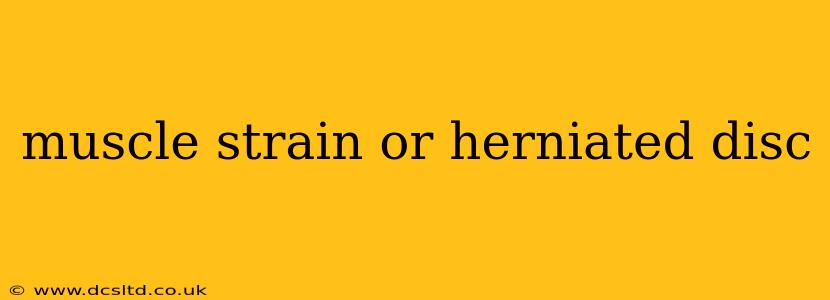Back pain is a common ailment, affecting millions worldwide. Two frequent culprits are muscle strains and herniated discs. While both can cause significant discomfort, they have different underlying causes, symptoms, and treatments. This comprehensive guide will help you understand the key distinctions between a muscle strain and a herniated disc, enabling you to better navigate your own back pain experience.
What is a Muscle Strain?
A muscle strain, also known as a pulled muscle, occurs when muscles in your back are overstretched or torn. This often happens due to sudden movements, overuse, or poor posture. Think lifting something heavy incorrectly, twisting awkwardly, or engaging in strenuous activity without proper warm-up. The severity of a strain varies, ranging from mild discomfort to significant pain and limited mobility. Symptoms usually include localized pain, muscle tenderness, and stiffness.
What is a Herniated Disc?
A herniated disc, on the other hand, involves a problem with the intervertebral discs in your spine. These discs act as cushions between the vertebrae, absorbing shock and allowing for flexibility. A herniation happens when the soft, inner part of the disc pushes through a tear in the tough outer layer. This can compress nearby nerves, leading to pain, numbness, tingling, or weakness that radiates down the leg (sciatica) or arm.
What are the Symptoms of a Muscle Strain?
What are the common symptoms of a muscle strain in the back?
Common symptoms of a muscle strain include:
- Localized pain: The pain is generally concentrated in the affected muscle group and doesn't typically radiate down the leg or arm.
- Muscle spasms: Involuntary muscle contractions can cause significant discomfort.
- Stiffness: Movement can be restricted due to pain and inflammation.
- Tenderness to the touch: The affected area feels sore when touched.
- Mild swelling: Some swelling might be present, but it's usually not as pronounced as with other injuries.
What are the Symptoms of a Herniated Disc?
How do I know if I have a herniated disc?
Identifying a herniated disc requires a proper medical diagnosis. However, several common symptoms might indicate a potential problem:
- Radiating pain: Pain often extends beyond the back, down the leg (sciatica) or arm. This is a key differentiator from a muscle strain.
- Numbness or tingling: Nerve compression can lead to sensations of numbness or tingling in the affected limb.
- Weakness: Muscle weakness in the leg or arm might occur due to nerve compression.
- Intense pain: The pain associated with a herniated disc can be quite severe, especially when coughing, sneezing, or straining.
- Limited range of motion: Movement might be severely restricted due to pain.
How are Muscle Strains and Herniated Discs Diagnosed?
How is a muscle strain or herniated disc diagnosed?
Both conditions are usually diagnosed through a physical examination and medical history review. Your doctor will assess your symptoms, palpate the affected area, and assess your range of motion. Imaging techniques such as X-rays, MRIs, or CT scans might be used to confirm the diagnosis, particularly for a suspected herniated disc. An MRI is generally the preferred method for visualizing disc herniations.
How are Muscle Strains and Herniated Discs Treated?
What is the treatment for a muscle strain or herniated disc?
Treatment approaches differ based on the specific diagnosis and severity of the condition. Muscle strains often respond well to conservative management, including:
- Rest: Avoiding activities that aggravate the pain.
- Ice: Applying ice packs to reduce inflammation.
- Over-the-counter pain relievers: Medications like ibuprofen or naproxen can help manage pain and inflammation.
- Heat: Applying heat after the initial inflammation subsides can help relax muscles.
- Physical therapy: Exercises and stretches to improve strength, flexibility, and posture.
Herniated discs might require a more involved approach, depending on the severity of symptoms and nerve compression. Treatment options can include:
- Conservative management: Similar to muscle strain treatment, but may require more extensive physical therapy.
- Epidural steroid injections: Injections to reduce inflammation around the nerve roots.
- Surgery: Surgical intervention is usually considered only as a last resort for severe cases that don't respond to conservative management.
When Should I See a Doctor?
When should I see a doctor for back pain?
It's crucial to seek medical attention if you experience:
- Severe pain: Intense or debilitating back pain.
- Radiating pain: Pain that extends down your leg or arm.
- Numbness or weakness: Loss of sensation or muscle weakness in your extremities.
- Bowel or bladder dysfunction: Changes in bowel or bladder control.
- Persistent pain: Back pain that doesn't improve after a few weeks of home treatment.
This information is for general knowledge and should not be considered medical advice. Always consult with a healthcare professional for diagnosis and treatment of any medical condition.
